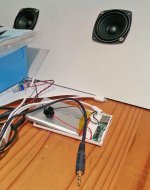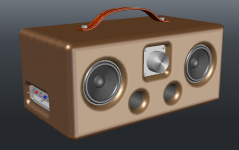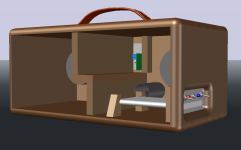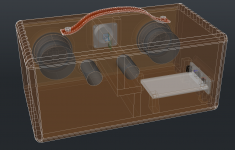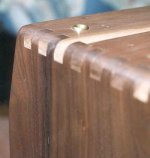the suggestion to filter out the very very bottom end (that the drivers can't handle) is a really good suggestion, thanx Bob. That 4th order 100Hz filter, how & where would you implement it? (See schematic attached) I see there are already some caps on the input (C2 + C4), this a good place?
To keep things simple, adjusting the input cap to the power amp to rolloff at 100HZ would be a good idea. It's only a one pole filter (6dB/octave), but simple and way better than nothing. If the input impedance of the power amp were 10K ohms, the cap would be
C = 1/ (2 times pie times 10K times 100HZ) = 0.16uF
so I'd put a 0.22uF cap there (standard value) (which puts you -3dB at 72HZ), but find out what that input impedance is and do the math for that number.
To keep things simple, adjusting the input cap to the power amp to rolloff at 100HZ would be a good idea. It's only a one pole filter (6dB/octave), but simple and way better than nothing. If the input impedance of the power amp were 10K ohms, the cap would be
C = 1/ (2 times pie times 10K times 100HZ) = 0.16uF
so I'd put a 0.22uF cap there (standard value) (which puts you -3dB at 72HZ), but find out what that input impedance is and do the math for that number.
Thank you for the info. According to pics the input resistors on the board is 10k, but I will inspect the actual values of the resistors and caps when the board arrives.
To keep things simple, adjusting the input cap to the power amp to rolloff at 100HZ would be a good idea. It's only a one pole filter (6dB/octave), but simple and way better than nothing. If the input impedance of the power amp were 10K ohms, the cap would be
C = 1/ (2 times pie times 10K times 100HZ) = 0.16uF
so I'd put a 0.22uF cap there (standard value) (which puts you -3dB at 72HZ), but find out what that input impedance is and do the math for that number.
Thank you for the info. According to pics the input resistors on the board is 10k, but I will inspect the actual values of the resistors and caps when the board arrives.
To keep things simple, adjusting the input cap to the power amp to rolloff at 100HZ would be a good idea. It's only a one pole filter (6dB/octave), but simple and way better than nothing. If the input impedance of the power amp were 10K ohms, the cap would be
C = 1/ (2 times pie times 10K times 100HZ) = 0.16uF
so I'd put a 0.22uF cap there (standard value) (which puts you -3dB at 72HZ), but find out what that input impedance is and do the math for that number.
Thank you for the info. According to pics the input resistors on the board is 10k, but I will inspect the actual values of the resistors and caps when the board arrives.
PAM8403 + lithium battery pack
https://www.youtube.com/watch?feature=player_detailpage&v=JNpoBOjpIao
https://www.youtube.com/watch?v=UPwpzvbvN94
https://www.youtube.com/watch?feature=player_detailpage&v=JNpoBOjpIao
https://www.youtube.com/watch?v=UPwpzvbvN94
Last edited:
https://www.youtube.com/watch?feature=player_detailpage&v=WV0VG_8li3M
https://www.youtube.com/watch?feature=player_detailpage&v=WV0VG_8li3M
https://www.youtube.com/watch?feature=player_detailpage&v=WV0VG_8li3M
This is my choice of a 5 volt amp. I use this amp in all of my builds. @ .36/Ea. it's hard to beat..
10 PCS PAM8403 Audio Ultra Module Mini Digital Power Amplifier Board 2 * 3W Class-in Integrated Circuits from Electronic Components & Supplies on Aliexpress.com | Alibaba Group
I figure the vol. control is not needed if one is using Bluetooth. The media device usually controls the volume and EQ.
I combine the amp with a Bluetooth dongle to provide enough current draw to keep the battery alive if it has automatic shut down.
Wholesale 10 Pcs/lot USB Bluetooth Audio Adapter Bluetooth Music Receiver 3.5mm Stereo for Car AUX, Home Speakers, PC-in Speakers from Consumer Electronics on Aliexpress.com | Alibaba Group
I combine the 2 units together in a 1/2" conduit junction box and mount speaker connectors to it. Now you can connect to any set of speakers you choose. Can be fed direct through a 3.5mm or via Bluetooth. Operates for days from a 5600mAh battery without the low current draw shut down circuit. (The amp alone doesn't draw enough current to keep the battery alive) Just need to control the audio input..
https://imageshack.com/a/fv24/1
10 PCS PAM8403 Audio Ultra Module Mini Digital Power Amplifier Board 2 * 3W Class-in Integrated Circuits from Electronic Components & Supplies on Aliexpress.com | Alibaba Group
I figure the vol. control is not needed if one is using Bluetooth. The media device usually controls the volume and EQ.
I combine the amp with a Bluetooth dongle to provide enough current draw to keep the battery alive if it has automatic shut down.
Wholesale 10 Pcs/lot USB Bluetooth Audio Adapter Bluetooth Music Receiver 3.5mm Stereo for Car AUX, Home Speakers, PC-in Speakers from Consumer Electronics on Aliexpress.com | Alibaba Group
I combine the 2 units together in a 1/2" conduit junction box and mount speaker connectors to it. Now you can connect to any set of speakers you choose. Can be fed direct through a 3.5mm or via Bluetooth. Operates for days from a 5600mAh battery without the low current draw shut down circuit. (The amp alone doesn't draw enough current to keep the battery alive) Just need to control the audio input..
https://imageshack.com/a/fv24/1
What chipset does the BT-modules integrate?
Regarding the "h-163" BT-id, i'd think of OVC3860. If so, they are hackable with some tools or by dumping the flash. (Been there, done that) Are there any noise issues from the module?
Quote..
Are there any noise issues from the module?
A slight bit of noise with no signal input. I believe it comes in the external wiring from the unit collecting tx/rx signal. I didn't try installing ferrite beads or anything to resolve it. Repositioning the wires around the completed unit helps but unnoticeable while music is playing. Not enough to worry about, IMO..
There is no ground loop issue, being that is how it's designed to be used..
Hacking anything is outta my league.. 😉
Are there any noise issues from the module?
A slight bit of noise with no signal input. I believe it comes in the external wiring from the unit collecting tx/rx signal. I didn't try installing ferrite beads or anything to resolve it. Repositioning the wires around the completed unit helps but unnoticeable while music is playing. Not enough to worry about, IMO..
There is no ground loop issue, being that is how it's designed to be used..
Hacking anything is outta my league.. 😉
Parts arrived ages ago and went straight into the cupboard. Finally got a chance to take it out and wire everything up (See attached).
I mounted the speakers in an old board just to separate front and back pressure waves and get an idea of quality... These little speakers output A LOT OF SOUND!
Played with the equalizer on my phone and I can actually get a lot of bass out of this make-shift setup... can't wait to hear it in a Cab!
I mounted the speakers in an old board just to separate front and back pressure waves and get an idea of quality... These little speakers output A LOT OF SOUND!
Played with the equalizer on my phone and I can actually get a lot of bass out of this make-shift setup... can't wait to hear it in a Cab!
Attachments
Thats why i dont step-up from 3.7V Li+ to 5V. Your 5V batterypack is actually a step-up-system, maybe a noisy one. Do you know the efficiency of this pack - guess not.
Anyway, like to see the results then.
@DoctorMord: You were right about the step-up circuit... it has a low frequency humm.
I first noticed it when I plugged into the 5V USB Port of the Powerbank. I remembered what you said, so I opened up the power supply and hooked up straight to the 3.7V battery.
SUPER CLEAN and at full volume with no input I have to use my imagination to hear a very faint hissss (I'm impressed with the quality considering that it's such a cheap chip).
Very happy with the power levels across all frequencies as well, no reason to run this chip at full power, 3.7V is more than enough!
I finished the cutting list for the cab. I decided to make it a bit more compact than the original design, but the cabs are still tuned around 100Hz so there should be enough bass.
So I ended up with 2 x 3L cabs (probaly more like 2.7L each with all the bits and bobs) and the cabs are sealed off from one another.
Amp can be replaced by removing the 4 screws on the front plate. Battery and stuff can be serviced in the same way on the side. The drivers are a bit harder to service / replace since I fit them before glueing the back panel. If they ever die then I'll have to destroy the back panel to get to them (lets hope that never happens).
There is a power switch with red LED to cut main power from the battery. There is another switch with a blue LED to cut the power to the bluetooth module when it is not in use (to save juice).
Let me know what you guys think and/or if I'm overlooking something before I start the build...?
So I ended up with 2 x 3L cabs (probaly more like 2.7L each with all the bits and bobs) and the cabs are sealed off from one another.
Amp can be replaced by removing the 4 screws on the front plate. Battery and stuff can be serviced in the same way on the side. The drivers are a bit harder to service / replace since I fit them before glueing the back panel. If they ever die then I'll have to destroy the back panel to get to them (lets hope that never happens).
There is a power switch with red LED to cut main power from the battery. There is another switch with a blue LED to cut the power to the bluetooth module when it is not in use (to save juice).
Let me know what you guys think and/or if I'm overlooking something before I start the build...?
Attachments
Looks great! I don't have the facilities to do any woodworking to that level but I wish I did..
How do you plan to properly charge the 3.7 volt battery? Bank batteries are easy but finding high capacity units that won't shut down during low current draw (Low Volume) is an issue for me..
I've never had a noise problem using bank batteries. The only time noise is noticed is when I operate the Bluetooth receiver and the amp from the same battery/same port. (Ground loop issue, I'm sure) If I use a separate battery to power the Bluetooth, the noise is gone..
I do have one battery with 2 USB ports at different current levels. (One @ 1 amp and the other at 2.1amp) If I connect the amp to the higher current port and the Bluetooth to the other, the background noise is gone. Perhaps the reason is 2 different step up converters? Still, if I operate the amp alone (Direct from the source, not using Bluetooth) and feed it via the 3.5 mm input, the battery still shuts down during low volume. The Bluetooth draws enough current to keep it alive while using both together..
Baffle Step Compensation can really fine tune your sound with these amps. I discovered this circuit and applied it to a few projects that were put on the back shelf because I couldn't get the sound that I was looking for. Now they are different units!
Keep us updated..
How do you plan to properly charge the 3.7 volt battery? Bank batteries are easy but finding high capacity units that won't shut down during low current draw (Low Volume) is an issue for me..
I've never had a noise problem using bank batteries. The only time noise is noticed is when I operate the Bluetooth receiver and the amp from the same battery/same port. (Ground loop issue, I'm sure) If I use a separate battery to power the Bluetooth, the noise is gone..
I do have one battery with 2 USB ports at different current levels. (One @ 1 amp and the other at 2.1amp) If I connect the amp to the higher current port and the Bluetooth to the other, the background noise is gone. Perhaps the reason is 2 different step up converters? Still, if I operate the amp alone (Direct from the source, not using Bluetooth) and feed it via the 3.5 mm input, the battery still shuts down during low volume. The Bluetooth draws enough current to keep it alive while using both together..
Baffle Step Compensation can really fine tune your sound with these amps. I discovered this circuit and applied it to a few projects that were put on the back shelf because I couldn't get the sound that I was looking for. Now they are different units!
Keep us updated..
I'm connecting strainght across the battery terminals for power (see pic). If I use the usb port to power the amp I get a pretty substatial hum as a back track...
Still waiting for the bluetooth module, probably gonna be a whole new can of worms when it arrives
Still waiting for the bluetooth module, probably gonna be a whole new can of worms when it arrives
What chipset does the BT-modules integrate?
Regarding the "h-163" BT-id, i'd think of OVC3860. If so, they are hackable with some tools or by dumping the flash. (Been there, done that) Are there any noise issues from the module?
doctormord, do you have a suggestion for a hackable bluetooth module? Sounds intriguing.
@DoctorMord: You were right about the step-up circuit... it has a low frequency humm.
I first noticed it when I plugged into the 5V USB Port of the Powerbank. I remembered what you said, so I opened up the power supply and hooked up straight to the 3.7V battery.
SUPER CLEAN and at full volume with no input I have to use my imagination to hear a very faint hissss (I'm impressed with the quality considering that it's such a cheap chip).
Very happy with the power levels across all frequencies as well, no reason to run this chip at full power, 3.7V is more than enough!
Nice to hear it works this way. Are you using it with a BT-module? I did some more investigation into another BT-module, problems seems always the same, somehow.
Is your battery still protected from deep-discharge/over current at this connections? Some power banks have their protection circuit on the main board rather than directly at the battery.
doctormord, do you have a suggestion for a hackable bluetooth module? Sounds intriguing.
What kind of hack are interested in? The OVC is hackable in the way that you can change BT-name, pin, connection behavior, sounds and blinking patterns. It's a bit uncomfortable as you need to "hack" the corresponding "PS-keys" but there's a tool around which makes this possible via serial connection.
If you need more, the CSR8635/45/70 might be the way to go. But those need a proper 1.8V SPI programmer and the tools from CSR which aren't widely available. (SDK/ADK/vendor branding tools)
But they have an integrated DSP and can even be used as an USB-Soundcard.
I've never had a noise problem using bank batteries. The only time noise is noticed is when I operate the Bluetooth receiver and the amp from the same battery/same port. (Ground loop issue, I'm sure) If I use a separate battery to power the Bluetooth, the noise is gone..
I do have one battery with 2 USB ports at different current levels. (One @ 1 amp and the other at 2.1amp) If I connect the amp to the higher current port and the Bluetooth to the other, the background noise is gone. Perhaps the reason is 2 different step up converters? ..
Mostly the problem is the poor decoupling at the power stage of the BT-modules. They conduct high-frequency back into the power supply. For different modules, the best fix from testing and simulation is a 10R series resistor + cap to ground right after with a real real low ESR and "much capacitance" (1000-2200uF). This forms an RC-low pass/filter which greatly reduces conducted noise.
Fixed those BT/staff-card/FM-radio/USB modules known from China this way with great success. Modules with differential outs aren't affected that much but also needs differential connection to the amp.
Last edited:
What kind of hack are interested in? The OVC is hackable in the way that you can change BT-name, pin, connection behavior, sounds and blinking patterns. It's a bit uncomfortable as you need to "hack" the corresponding "PS-keys" but there's a tool around which makes this possible via serial connection.
If you need more, the CSR8635/45/70 might be the way to go. But those need a proper 1.8V SPI programmer and the tools from CSR which aren't widely available. (SDK/ADK/vendor branding tools)
But they have an integrated DSP and can even be used as an USB-Soundcard.
Don't want to hijack the thread, but I'd be interested to know if you've had any success with the CSR8635/45/70. Sounds like such a powerful tool for a small price if you can get the DSP working on some of those inexpensive cards. There are some vendors on aliexpress that sell SPI programmers and "software" but I'm not sure that can be trusted.
Yeah did so via LPT_SPI. There are some cheap programmers at Ali, like $18-20 without software. Just make sure, it is a 1.8V + 3.3V. They are pretty much all the same - copy of the CSR programmer based on a Bluecore 3 or 4. If you have a real LPT, you can also program via this, I have made a schematic available on my website. I used a CSR8545 to do the tests. DSP etc, all working. The 8670 can do some more DSP stuff. If you won't code C/C++ you're limited to the stuff provided with the ADK or standard setups but this is more than enough. 😀 I like the EQ+Compressor thing a lot, presets can be cycled by button/gpio.
So, back to topic. ^^
So, back to topic. ^^
- Status
- Not open for further replies.
- Home
- Amplifiers
- Class D
- 5V Portable Amp: Pre-build Discussion
